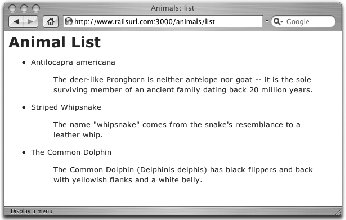Recipe 3.8. Iterating Over an Active Record Result Set
ProblemYou've used the find method of Active Record to fetch a set of objects. You want to iterate over this result set in both your controller and its associated view. SolutionThe solution uses a database of animals with names and descriptions. Create this model with: $ ruby script/generate model Animal and then add the following to the generated animal migration to both define the schema and add a few animals to the database: db/migrate/001_create_animals.rb: class CreateAnimals < ActiveRecord::Migration def self.up create_table :animals do |t| t.column :name, :string t.column :description, :text end Animal.create :name => 'Antilocapra americana', :description => <<-EOS The deer-like Pronghorn is neither antelope nor goat -- it is the sole surviving member of an ancient family dating back 20 million years. EOS Animal.create :name => 'Striped Whipsnake', :description => <<-EOS The name "whipsnake" comes from the snake's resemblance to a leather whip. EOS Animal.create :name => 'The Common Dolphin', :description => <<-EOS (Delphinis delphis) has black flippers and back with yellowish flanks and a white belly. EOS end def self.down drop_table :animals end end controllers/animals_controller.rb retrieves all the animal records from the database. Iterate over the result set and perform a simple shift cipher on each animal name, storing the result in an array: class AnimalsController < ApplicationController def list @animals = Animal.find(:all, :order => "name") end end Now display the contents of both animal arrays in views/animals/list.rhtml, using two different Ruby loop constructs: <h1>Animal List</h1> <ul> <% for animal in @animals %> <li><%= animal.name %> <blockquote> <%= animal.description %> </blockquote> </li> <% end %> </ul> DiscussionIn the solution, the find command returns all the animals from the database and stores them, ordered by name, in the @animals array. This array variable is preceded by an @ sign, making it an instance variable, and therefore available to the view (list.rb). The MVC idiom is to pass variables containing data structures to views, letting the views determine how to iterate over or otherwise display the data. So in the list view, we iterate over the @animals array with a for statement, which uses the Array class's each iterator. Each iteration stores an Animal object in the animal variable. For each animal, we print its name and description. Figure 3-1 shows the results of our iteration in the view. Figure 3-1. Iterating over a list of animals See Also
|
EAN: 2147483647
Pages: 250
- An Emerging Strategy for E-Business IT Governance
- A View on Knowledge Management: Utilizing a Balanced Scorecard Methodology for Analyzing Knowledge Metrics
- Measuring ROI in E-Commerce Applications: Analysis to Action
- Governing Information Technology Through COBIT
- Governance in IT Outsourcing Partnerships